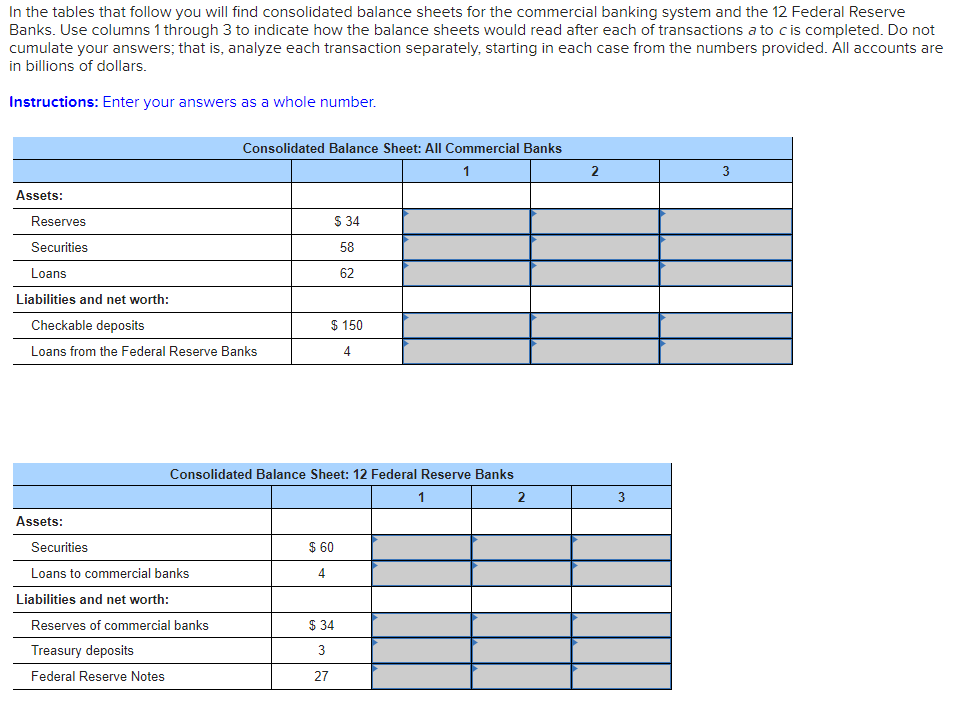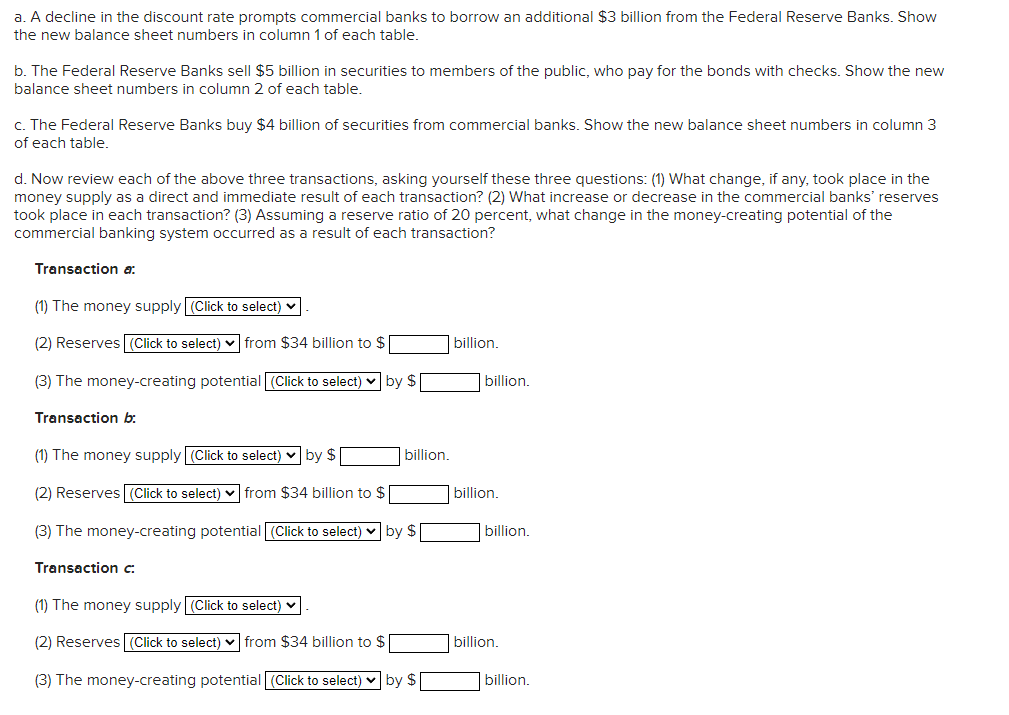a. A decline in the discount rate prompts commercial banks to borrow an additional $3 billion from the Federal Reserve Banks. Show the new balance sheet numbers in column 1 of each table. b. The Federal Reserve Banks sell $5 bllion in securities to members of the public, who pay for the bonds with checks. Show the new balance sheet numbers in column 2 of each table. c. The Federal Reserve Banks buy $4 billion of securities from commercial banks. Show the new balance sheet numbers in column 3 of each table. d. Now review each of the above three transactions, asking yourself these three questions: (1) What change, if any, took place in the money supply as a direct and immediate result of each transaction? (2) What increase or decrease in the commercial banks' reserves took place in each transaction? (3) Assuming a reserve ratio of 20 percent, what change in the money-creating potential of the commercial banking system occurred as a result of each transaction?
a. A decline in the discount rate prompts commercial banks to borrow an additional $3 billion from the Federal Reserve Banks. Show the new balance sheet numbers in column 1 of each table. b. The Federal Reserve Banks sell $5 bllion in securities to members of the public, who pay for the bonds with checks. Show the new balance sheet numbers in column 2 of each table. c. The Federal Reserve Banks buy $4 billion of securities from commercial banks. Show the new balance sheet numbers in column 3 of each table. d. Now review each of the above three transactions, asking yourself these three questions: (1) What change, if any, took place in the money supply as a direct and immediate result of each transaction? (2) What increase or decrease in the commercial banks' reserves took place in each transaction? (3) Assuming a reserve ratio of 20 percent, what change in the money-creating potential of the commercial banking system occurred as a result of each transaction?
Chapter1: Financial Statements And Business Decisions
Section: Chapter Questions
Problem 1Q
Related questions
Question

Transcribed Image Text:In the tables that follow you will find consolidated balance sheets for the commercial banking system and the 12 Federal Reserve
Banks. Use columns 1 through 3 to indicate how the balance sheets would read after each of transactions a to cis completed. Do not
cumulate your answers; that is, analyze each transaction separately, starting in each case from the numbers provided. All accounts are
in billions of dollars.
Instructions: Enter your answers as a whole number.
Consolidated Balance Sheet: All Commercial Banks
1
2
Assets:
Reserves
$ 34
Securities
58
Loans
62
Liabilities and net worth:
Checkable deposits
$ 150
Loans from the Federal Reserve Banks
Consolidated Balance Sheet: 12 Federal Reserve Banks
1
2
Assets:
Securities
$ 60
Loans to commercial banks
4
Liabilities and net worth:
Reserves of commercial banks
$ 34
Treasury deposits
3
Federal Reserve Notes
27

Transcribed Image Text:a. A decline in the discount rate prompts commercial banks to borrow an additional $3 billion from the Federal Reserve Banks. Show
the new balance sheet numbers in column 1 of each table.
b. The Federal Reserve Banks sell $5 billion in securities to members of the public, who pay for the bonds with checks. Show the new
balance sheet numbers in column 2 of each table.
c. The Federal Reserve Banks buy $4 billion of securities from commercial banks. Show the new balance sheet numbers in column 3
of each table.
d. Now review each of the above three transactions, asking yourself these three questions: (1) What change, if any, took place in the
money supply as a direct and immediate result of each transaction? (2) What increase or decrease in the commercial banks' reserves
took place in each transaction? (3) Assuming a reserve ratio of 20 percent, what change in the money-creating potential of the
commercial banking system occurred as a result of each transaction?
Transaction a.
(1) The money supply (Click to select) v
(2) Reserves (Click to select) v from $34 billion to $
billion.
(3) The money-creating potential (Click to select) v by $
billion.
Transaction b:
(1) The money supply (Click to select) v by $
| billion.
(2) Reserves (Click to select) v from $34 billion to $
billion.
(3) The money-creating potential (Click to select) ♥ by $
billion.
Transaction c.
(1) The money supply (Click to select) v
(2) Reserves (Click to select) v from $34 billion to $
billion.
(3) The money-creating potential (Click to select) - by $
billion.
Expert Solution
This question has been solved!
Explore an expertly crafted, step-by-step solution for a thorough understanding of key concepts.
This is a popular solution!
Trending now
This is a popular solution!
Step by step
Solved in 3 steps

Recommended textbooks for you


Accounting
Accounting
ISBN:
9781337272094
Author:
WARREN, Carl S., Reeve, James M., Duchac, Jonathan E.
Publisher:
Cengage Learning,

Accounting Information Systems
Accounting
ISBN:
9781337619202
Author:
Hall, James A.
Publisher:
Cengage Learning,


Accounting
Accounting
ISBN:
9781337272094
Author:
WARREN, Carl S., Reeve, James M., Duchac, Jonathan E.
Publisher:
Cengage Learning,

Accounting Information Systems
Accounting
ISBN:
9781337619202
Author:
Hall, James A.
Publisher:
Cengage Learning,

Horngren's Cost Accounting: A Managerial Emphasis…
Accounting
ISBN:
9780134475585
Author:
Srikant M. Datar, Madhav V. Rajan
Publisher:
PEARSON

Intermediate Accounting
Accounting
ISBN:
9781259722660
Author:
J. David Spiceland, Mark W. Nelson, Wayne M Thomas
Publisher:
McGraw-Hill Education

Financial and Managerial Accounting
Accounting
ISBN:
9781259726705
Author:
John J Wild, Ken W. Shaw, Barbara Chiappetta Fundamental Accounting Principles
Publisher:
McGraw-Hill Education